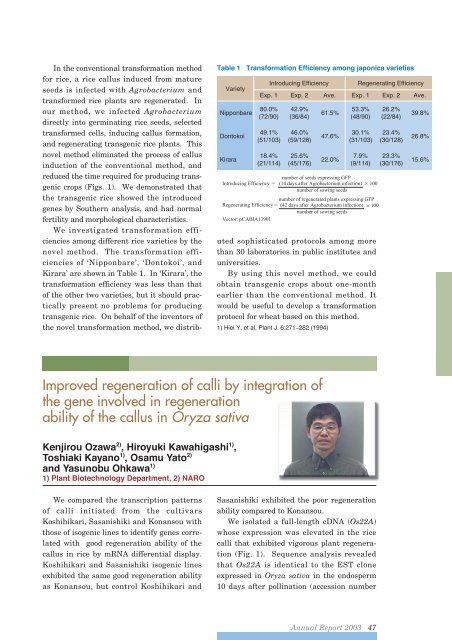You also want an ePaper? Increase the reach of your titles
YUMPU automatically turns print PDFs into web optimized ePapers that Google loves.
Table 1 Transformation Efficiency among japonica varietiesVarietyNipponbareDontokoiKiraraExp. 180.0%(72/90)49.1%(51/103)18.4%(21/114)Introducing EfficiencyExp. 242.9%(36/84)46.0%(59/128)25.6%(45/176)Ave.61.5%47.6%22.0%Exp. 153.3%(48/90)30.1%(31/103)7.9%(9/114)number of seeds expressing GFPIntroducing Efficiency = (14 days after Agrobacterium infection) × 100number of sowing seedsnumber of regenerated plants expressing GFPRegenerating Efficiency = (42 days after Agrobacterium infection) × 100number of sowing seedsVector: pCABIA13901In the conventional transformation methodfor rice, a rice callus induced from matureseeds is infected with Agrobacterium andtransformed rice plants are regenerated. Inour method, we infected Agrobacteriumdirectly into germinating rice seeds, selectedtransformed cells, inducing callus formation,and regenerating transgenic rice plants. Thisnovel method eliminated the process of callusinduction of the conventional method, andreduced the time required for producing transgeniccrops (Figs. 1). We demonstrated thatthe transgenic rice showed the introducedgenes by Southern analysis, and had normalfertility and morphological characteristics.We investigated transformation efficienciesamong different rice varieties by thenovel method. The transformation efficienciesof ‘Nipponbare’, ‘Dontokoi’, andKirara’ are shown in Table 1. In ‘Kirara’, thetransformation efficiency was less than thatof the other two varieties, but it should practicallypresent no problems for producingtransgenic rice. On behalf of the inventors ofthe novel transformation method, we distributedsophisticated protocols among morethan 30 laboratories in public institutes anduniversities.By using this novel method, we couldobtain transgenic crops about one-monthearlier than the conventional method. Itwould be useful to develop a transformationprotocol for wheat based on this method.1) Hiei Y, et al, Plant J. 6:271282 (1994)Regenerating EfficiencyExp. 226.2%(22/84)23.4%(30/128)23.3%(30/176)Ave.39.8%26.8%15.6%Improved regeneration of calli by integration ofthe gene involved in regenerationability of the callus in Oryza sativaKenjirou Ozawa 2) , Hiroyuki Kawahigashi 1) ,Toshiaki Kayano 1) , Osamu Yato 2)and Yasunobu Ohkawa 1)1) Plant Biotechnology Department, 2) NAROWe compared the transcription patternsof calli initiated from the cultivarsKoshihikari, Sasanishiki and Konansou withthose of isogenic lines to identify genes correlatedwith good regeneration ability of thecallus in rice by mRNA differential display.Koshihikari and Sasanishiki isogenic linesexhibited the same good regeneration abilityas Konansou, but control Koshihikari andSasanishiki exhibited the poor regenerationability compared to Konansou.We isolated a full-length cDNA (Os22A)whose expression was elevated in the ricecalli that exhibited vigorous plant regeneration(Fig. 1). Sequence analysis revealedthat Os22A is identical to the EST cloneexpressed in Oryza sativa in the endosperm10 days after pollination (accession number<strong>Annual</strong> <strong>Report</strong> <strong>2003</strong> 47













